Your cart is empty
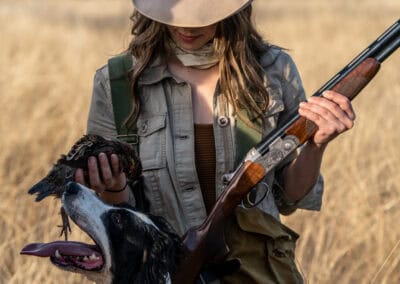
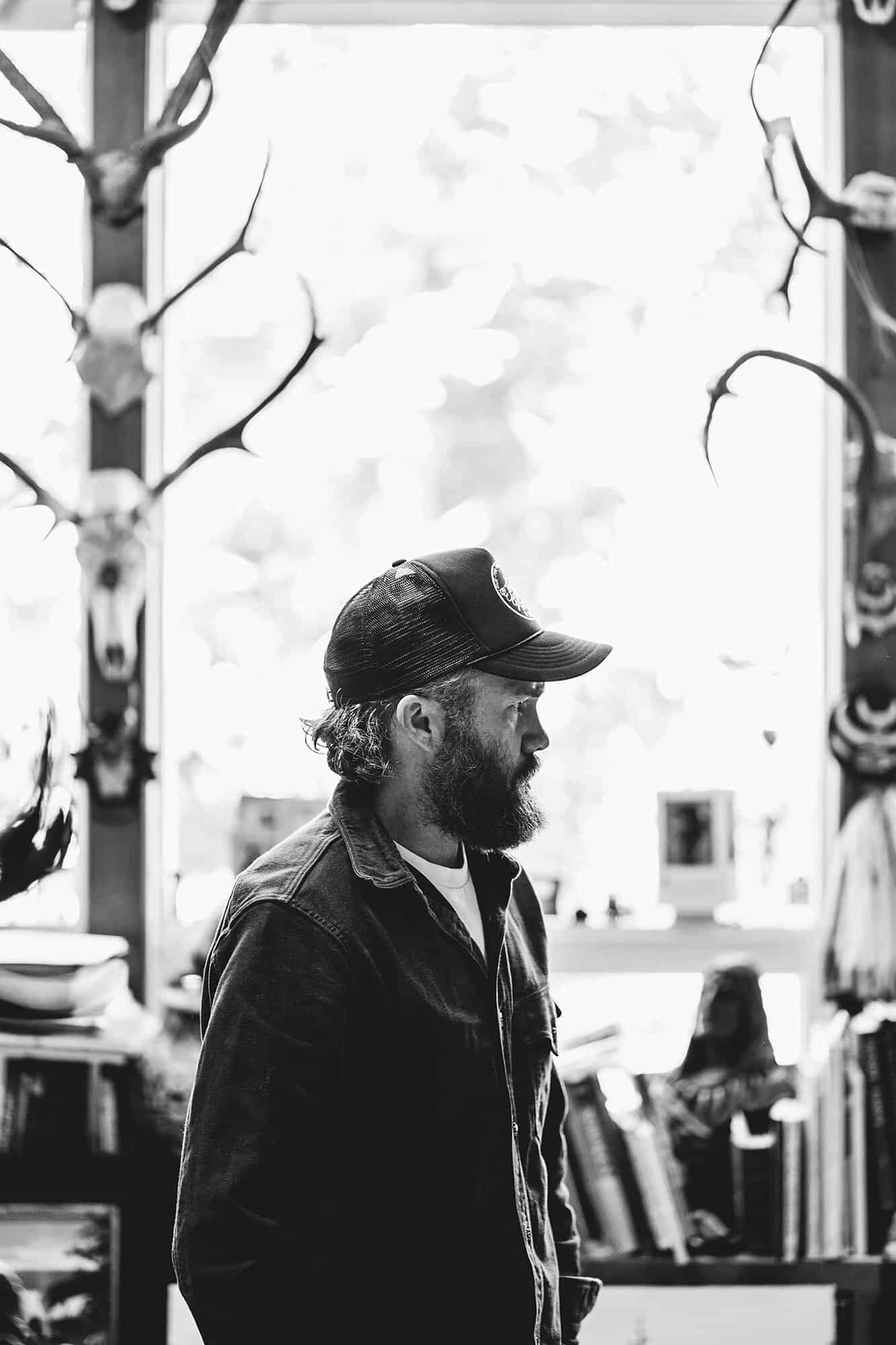
Western American Art has long defied categories and stylistic borders. Pioneering artists, shunned by traditional galleries, ripped assorted styles from classical works and artists. Yet these artists deviated from the usual classical subjects of delicate kings and queens or religious dogma; they were deemed rogues in their refusal to depict a natural world tamed by human hands. Many of the earlier artists in this genre applied impressionism, realism and expressionism to rougher motifs deemed unfit for white-gloved parlors and salons: rugged trail-breakers, fearless explorers, weary cowboys, wild game hunters, Native American warriors, contested ancestral lands and the ancient cultures who roamed their expansive landscapes. Western American art, throughout all its pivotal movements, guides the observer from a mere subject to a sense of wild places and wild people far outside of modern society.
Yet Western art continues its struggle to take its rightful place among mainstream audiences and the celebrated gallery walls long held hostage by curators and critics who evade both its artists and their work. For modern Western artist Nicholas Coleman, this culture clash serves as an appealing element that draws in an audience eager to trade modern life and art for wild landscapes. It’s a source of inspiration that leads him to cast Western American art with a wider lens. His work emboldens free-spirited imagination, while his cultural outreach encourages his followers to experience the West for themselves. This desire to push his audience to explore the raw landscapes in their own lives emanates from his core belief that those who cherish Western landscapes will, in turn, come to protect them. Nicholas Coleman is known for his efforts to increase access to America’s wild places, but accessibility to art is a recurring theme in his approach to his clientele as well. “So lately, I’ve thought the exact same thing, [sic] accessibility, because I really do want artwork in the hands of everybody. And a lot of times, it might not make business sense. But if someone’s excited about something, I’m willing to give them a great deal.”
Nicholas Coleman’s work emphasizes the key elements of a good story: scene, structure, event and plot. Every intentional brush stroke builds a story that evokes the common narrative of struggle, fortitude, and resiliency through both characters and the characterization. His romantic paintings inspire his audience to join his mission to preserve the fading heritage of the American West. Much of this is a result of his upbringing under his father, famed Western American artist Michael Coleman.
We recently spent time with Nicholas at his studio in Provo, Utah, to learn more about his work and the headwinds he embraces from critics and artists alike. We also discuss his successful use of social media to usher in a wider acceptance of Western artists and patrons by introducing new audiences to the people and culture of the West.
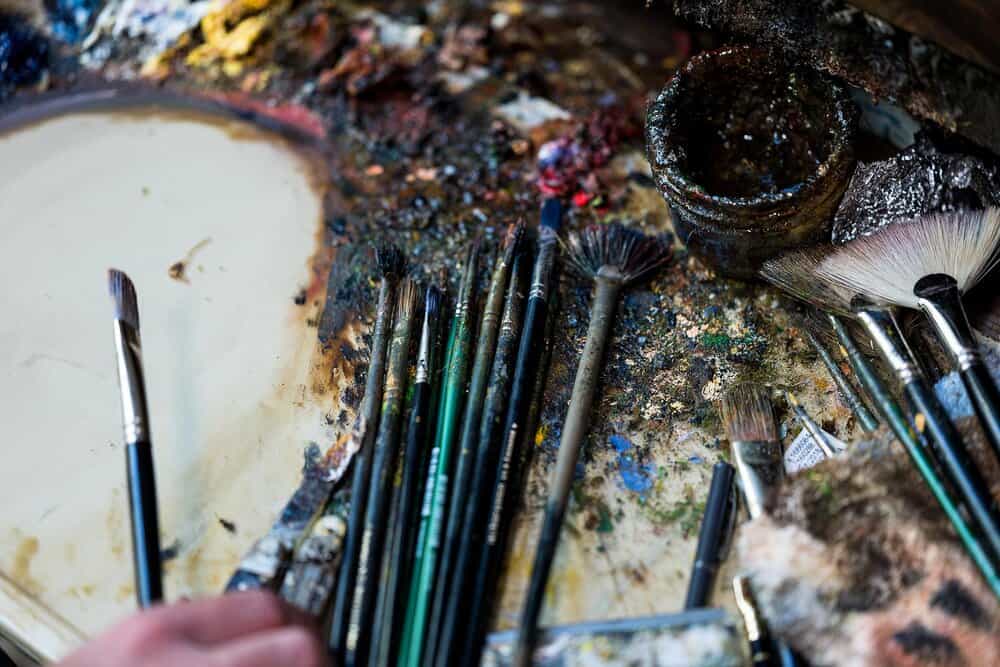
BILL RODEN — Tell us a little bit about your background. How did you get into painting, and what does it mean to you?
NICHOLAS COLEMAN — Growing up here in Provo, Utah, my father, Michael Coleman, was an artist as well. We would go do father-and-son type things. He’d take us fishing and hunting, and he even had a trap line here in Provo.
There used to be a golf course next to where we lived, so we were the muskrat trappers for the golf course — as a kid, that was great. Dad taught me how to skin a muskrat there. He also would give me a lot of books to read about the American West and buffalo and life and death in Yellowstone, and Barretech books. That was always magic to me, the history of the American West and the peoples that lived here and the early mountain men that came through this area.
When I came around, my dad would point out all the old places he used to go to and show me how they’d been ruined, but he also was looking constantly for new places to go. And that’s how I was with my dad, just hunting, going out in the woods, and in our backyard, in the Wasatch Mountains, climbing the cliffs up behind my house.
Of all my siblings, I was the one that wanted to do those things the most, which hopefully made my dad happy. My mom probably got a little worried, with us heading up to Alaska and British Columbia to go moose hunting and things like that.
My dad went to Africa a lot, and I always thought he was going to be eaten by a crocodile or nailed by a buffalo or something, which from the stories I’ve heard, he came very close a few times. And I’m struck that he’s still around at 74 years old, and not done. We talked about Teddy Roosevelt a lot and looked to him for just how life should be lived — not coddled and not comfortable by any means.
Everybody gets so used to being comfortable, and that’s not how the world works and not how it should be working. There’s so much of this world I have yet to see, and I’ve seen a lot of it, but I want to see more. And I’m constantly looking for new adventures and new experiences. I don’t know if that’ll ever die inside me.
By the time I was 21, I knew I wanted to be an artist like my dad. And I never thought it was easy, it’s just one of those funny things that you enjoy, that you love and appreciate. And then you hope someone else is out there that has that same love and appreciation and is willing to pay you money to do it. But I count myself quite fortunate, and my father as well, to be doing this.
One of my mom’s requests of me, when I was younger, was, “Okay, you finish college and then you can do whatever you want. If you want to be an artist, you can do that, but I want you to weigh your options and see what else is out there beside this.” So I finished college within two years. Every semester I went, I thought, I got to get this. If I stop, I’ll never go back because I hate this.
I worked full-time in my dad’s studio painting, and then I felt like I was going to school part-time, but still taking 15 credits here, 10 credits there. I was a busy guy, trying to get all the stuff done. I hated being on campus and trying to date.
I met my wife way back when, but we hooked up later in life when I ran into her again. I sat down with my parents when I was 21 and they said, “Okay. Now, are you sure this is what you want to do? This isn’t an easy thing to do.” And I said, “I never thought it was. I can’t imagine anything else I want to do. I’ve been mentally preparing myself since high school.”
That’s definitely how I got into it, just watching my dad. It’s a lot of hard work. I got an apprenticeship under him without knowing that was what it was. I was just being his son, getting the paintings packaged, making sure they were getting photographed, driving things around, delivering things up at Jackson Hole.
I was just the errand boy, but then that transferred into, “Oh, I know how to do everything for myself now.”
My dad always joked about how he was the worst teacher because he was self-taught when it came to art. He went to college as well, but one of the professors took him aside and said, “You’ve got to get out of here. These guys are going to ruin you. They hate your guts.”
So I just kept painting and working, and then some doors opened up.
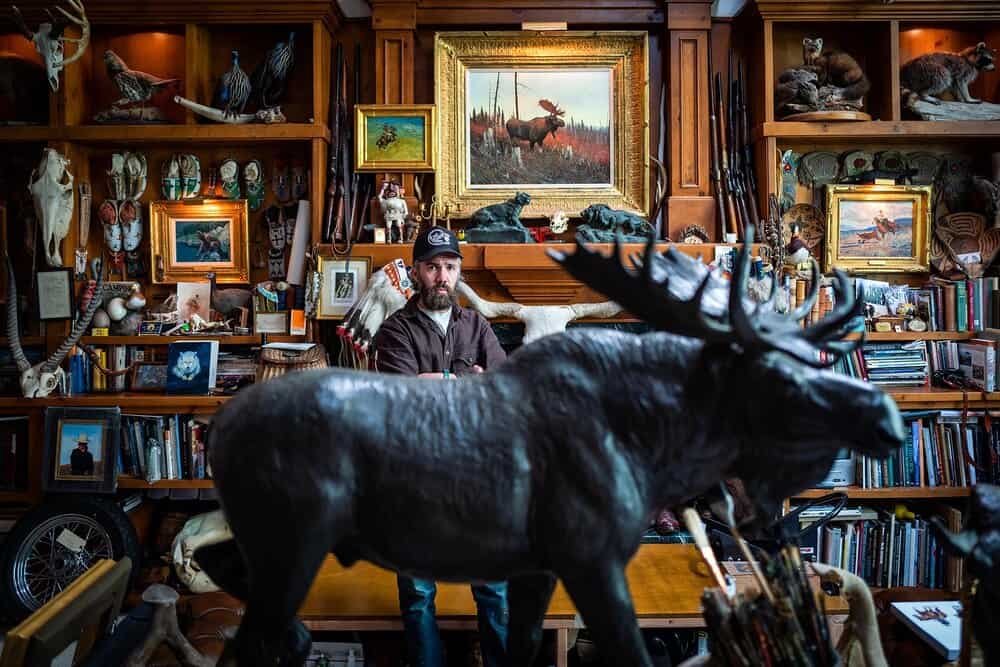
BR — Take us through some of the process of artistic growth. What were some of your earliest breakthroughs, and what do you feel are your current strengths?
NC — Some of the earliest wildlife paintings that I loved to paint: birds, nests in their habitat, and life on the edge — hawks catching rabbits and squirrels. The interactions I saw spending time in the outdoors and in the boy scouts.
These are still current themes that I have in my paintings, man’s eternal interaction with the natural world — less telephone poles and less parking lots and 7-Elevens. I think my enthusiasm early in my career, when I was a teenager and in my formative years, kept me pushing forward. I always had this confidence, but I think the hope for every artist is you’re getting better with every single painting. And the more time you spend painting and the more time you spend observing, you’re hopefully just absorbing all that information and energy that you can put back. I think enthusiasm for your subject goes a long way. I’ve talked to certain artists that said, “Should I start with a landscape?” I’m like, “Well, do you like the landscape?” “Oh, no. I hate the landscape. But you gotta start there.”
And I say, “Don’t do that. What do you love? Do that and do that better than anybody.” And that’s what my dad’s advice to me was when I was deciding to be an artist. He asked, “What do you think about before you go to bed at night?” I said, “What I’m going to paint the next day.” He’s like, “Well, that’s good. That’s the answer I wanted to hear, because if there was anything else, I was going to say, ‘Do that.’”
I’d put a moose in one of my paintings, and then it brings back all your funny memories for, say, a moose hunt, the fall smell, the dead, dying leaves. Or after you shoot the moose, there’s a certain smell that you just never forget, and the hard work of quartering it to get it out. I think pulling the trigger is the easy part when it comes to hunting. And if you’re a real hunter, you know that there’s a lot more to it than just that. And I think that’s what a lot of people fail to see when it comes to hunting and conservation. They think it’s just a killing spree. And I’ve had a few social media things where people are like, “How could you?”
It was a painting of a hunter or a dead animal, and people freak out just about painting something like that, let alone a photograph. I’ve tried to be cautious navigating all that fun stuff just because I want to not have to worry about it… I try not to engage when it comes to idiots on social media, Facebook or Instagram.
And it’s just not worth it and it just falls on deaf ears 99% of the time. There’s always room for people who are actually researching and reading if they’re interested in it. There’s Carl Akeley, who was in charge of the Natural Museum in New York, the African wing. He was hunting with Teddy Roosevelt in Africa in the early 1900s, and he talked about how people only love the cuddly animals. In the early 20th century, they couldn’t care less about the snakes and the frogs or the insects or that the whole natural world is one organism.
I know people get upset with the natural history museums, but they’re showing the world and how much bigger the world was than just, say, New York or people’s little towns and cities. And kids need the imagination. They need to see the natural world. And if you don’t have an opportunity in these big cities, where else are you going to get it but these museums?
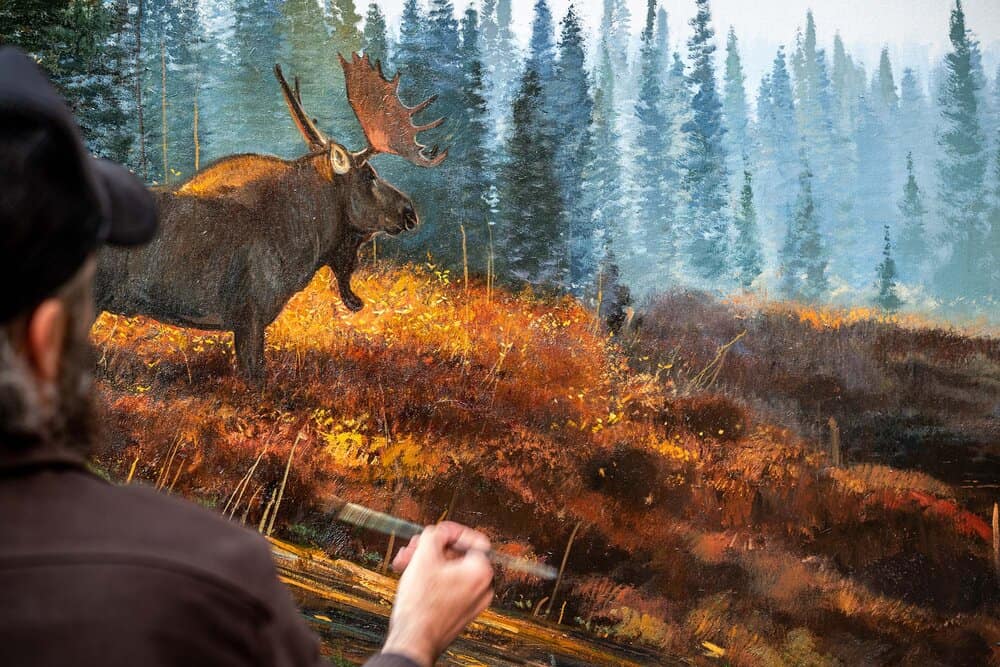
BR — So it says your work has a somewhat editorial feel, as if you’re imagining a world and capturing those romantic in-between moments that make the Western way of life otherworldly. Take us through your thought process on story and composition.
NC — So, when it comes to my paintings, even when it comes to the bushes and sticks and twigs, the willows that, when you are a hunter, you climb through it and you weave your way in and out of it and have to scramble over it. You appreciate those kinds of things. And when you’re looking at a painting, you think, “Hey, I have been there” — that’s what I want to do. And I think it happens not on purpose, but it’s just the way I like to tell a story.
BR — You post on Instagram about the history of great Western artists who came before. Who were the key artists who influenced you the most, and in your opinion, which of these artists captured the true spirit of the American West the most?
NC — I’ve tried to educate people on Instagram just because I love it. And it’s like talking about Teddy Roosevelt or Carl Akeley, artists and certain figures that came and helped preserve the American West. Often with history, people look at it in a negative light. But the thing is it happens and you cannot erase it. And you need to preserve it, the good and the bad, and enjoy all aspects of it.
I do try to find the in-between moments, the back-in-camp moments or after they’ve skinned the animal and they’re bringing it home. It’s a way of life. I mean, it is life. The artist that I definitely look up to is the German-born artist, Carl Rungius, who spent a lot of time up in Montana and Canada and the Canadian Rockies hunting moose.
In a lot of his books, he has drawings of skinned animals. He did all these amazing studies and these etchings. So for wildlife historical artists, definitely Carl Rungius. And then those Western artists like Frank Tenney Johnson.
Certain cowboy artists: William R. Lewis and Thomas Moran, and Hans Von Bastad, another German guy that came through the 1880s. He’s known for painting a lot of Yosemite landscapes in the Sierra Nevadas and places that help cement the American Western in the imagination of the whole world as a destination place that they needed to visit before they died. But a lot of my heroes, they’re all dead.
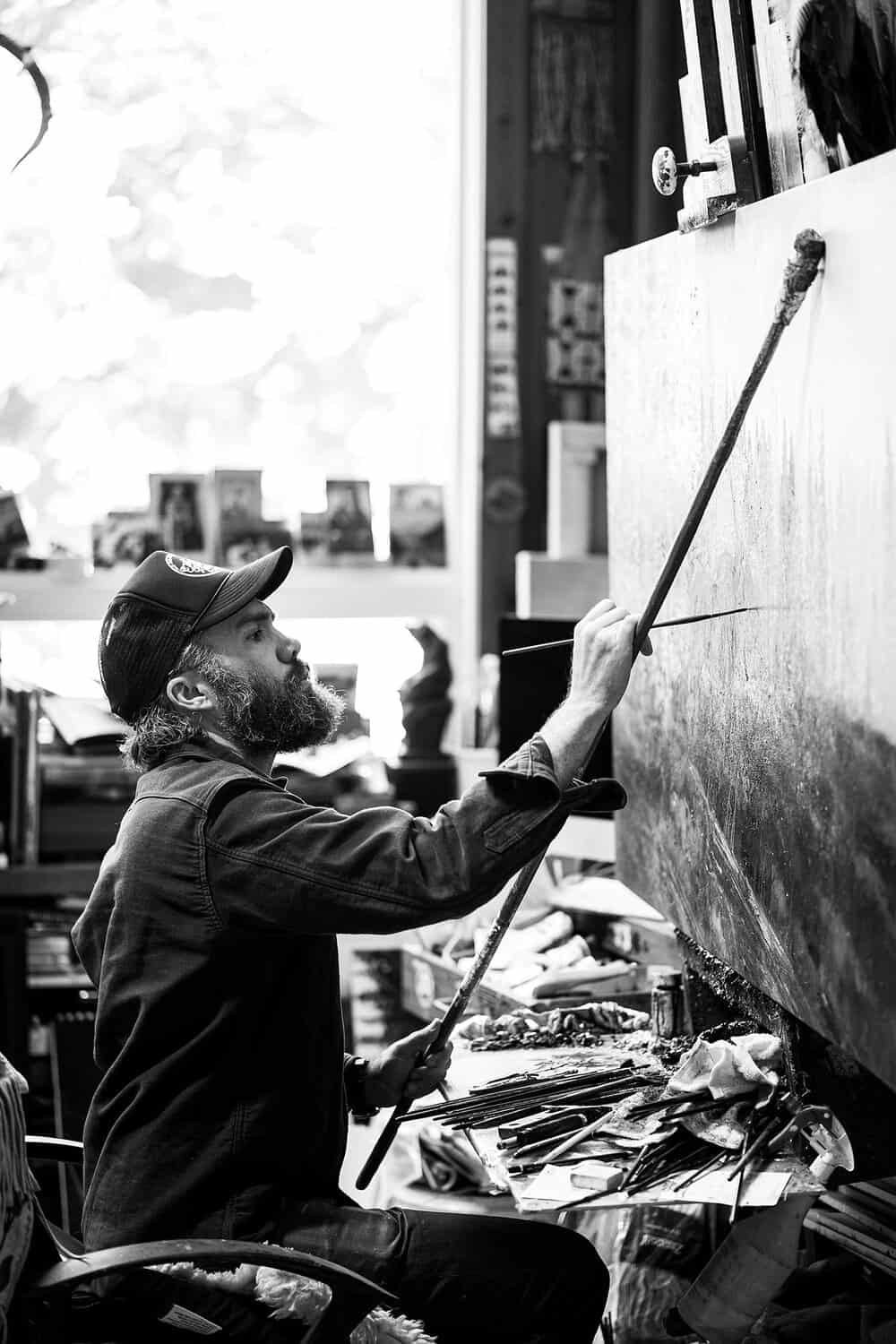

BR — Tell us a little bit about what a day in your life is like. More so, how are you living the world you’ve created, and how would you describe the current culture around what you’re doing, the crossing-over lifestyle between hunting, Western art and motorcycle culture?
NC — Growing up here in Provo, Utah was a nice bubble. My dad grew up loving the West and the Native Americans and the culture and then the way of life and hunting and growing up in the ‘50s and ‘60s in Utah. And all the stories I’ve heard, it’s pretty magical.
I’m constantly hunting here in Utah, and fishing and fly fishing and traveling. I don’t think a lot of people in Provo know what my dad has done or even myself.
I’m not too concerned about everybody knowing. I’m probably more known outside of Utah than in Utah, for whatever reason. For galleries, Montana has been great and Jackson Hole has been great; New Mexico has been good and New York of all places too has been pretty good over the years, and then recently in Texas. And as I’ve gotten older, my name’s gotten out a little bit more. It’s provided me with more means in order to do exactly what I want to do. And what’s been fantastic about my particular work when it comes to hunting and wildlife is I’ll meet like-minded people that will invite me to go on hunting trips, which makes it a lot more fun.
You saw my land cruiser with the tent on top. It’s amazing to just grab the kids and head up eight hours north and get out of town. And I want my kids to live the same way, because it’s magic. Especially if it’s miserable, they’re really going to remember it.
BR — So you’ve talked a little bit about how hunting plays into your work. But as a hunter yourself, knowing that your work crosses over between multiple genres, what are some of those themes you like to pursue around hunting?
NC — I think when it comes to my paintings, it’s just a reminder that it’s out there still. I do like to make things timeless and just look at it and you go, “Yeah, that could be now or that could be 100 years ago.” And I want to keep that. There is something about hunting that feels old-fashioned even though we’re living in modern times, and I think some people think, “Oh, we’re too civilized.” The world is not civilized.
And it’s one of those things for me, and I think my dad too, it’s a compulsion. And part of it is just bringing our love of what we do to everybody else that loves it too and who’s been out there as well. And it’s always fantastic to meet like-minded people, and you share your stories. It’s not even about bragging about anything, it’s just sharing.
And my dad is the first guy to share. He never says no to anybody to come see his studio, because he likes to share it. He just loves to share everything and loves the world and the natural world and all the fantastic things that are to see in it.
In July, my son did a ski camp. So we went to Mount Hood, and while he was at ski camp, we were doing hikes, and I was getting up early in the morning to go hike through this scary, creepy forest.
It was early in the morning, and I was looking at the giant volcano with Mount Hood right there and I’m like, “This is my first time. This is amazing. That’s a volcano. That’s a lake. There’s a funny guy right there fishing with a spinning rod and there’s a fire and there’s blue smoke coming off the side.”
And that just sparked a lot. I went through my photographs, looking through different color combinations. Every morning, my wife and I went back to the same spot, and while she was running, I was taking photographs and trying to look at different things. People were out canoeing, and they didn’t know it, but they were all my models posing in different places. And there were some flying ducks swimming by and they’d come up thinking you’re going to feed them, but they’re being models. And they’ll probably end up in a painting or two coming up here.
It’s funny — just going outside, my brain just wakes up and people go, “What is wrong with you?”
And it’s not so much like I’m containing enthusiasm. It’s just, I love seeing it and I continue to love seeing it. And the sun will do so many different things and cloud combinations of light early in the morning and then late at night when the sun’s going down.
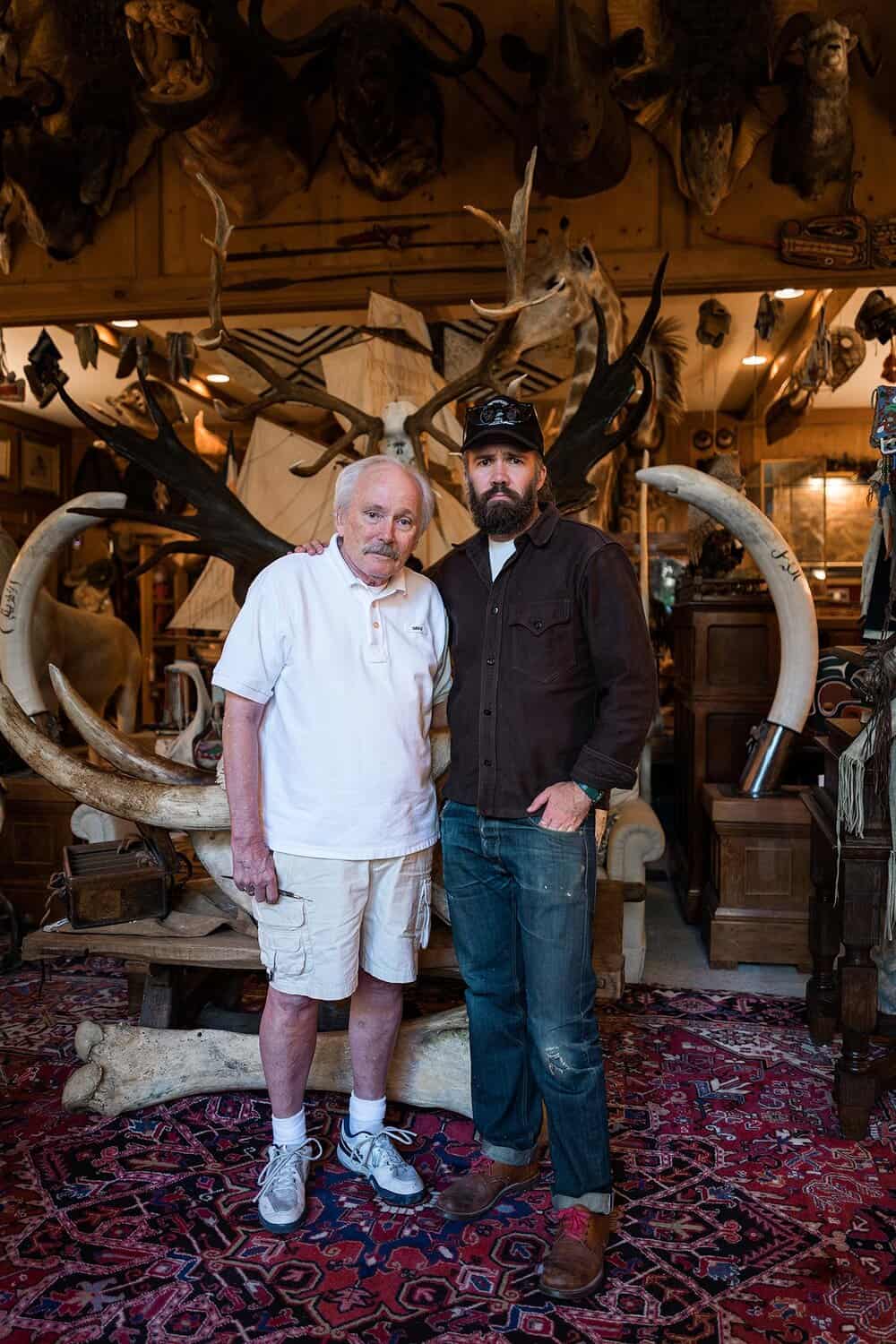
BR — Tell us about your patrons, where you’re selling your work and what the current state of the Western Art gallery world is. How do you navigate that?
NC — I have a lot of repeat customers, thank goodness — clients that must be like-minded people that like certain things. And I have a few clients that I’m shocked about, like the president of Uline. This year, all the museum shows got closed down. A lot of galleries closed down for a few months. She was bummed out that she didn’t even have the opportunity to buy any paintings, so she just reached out directly and she probably got some fantastic deals.
This has been an interesting year in that people have just been reaching out: “Hey, what are you working on? Can I see anything? Do you have any moose paintings? Do you have any of this?” And I’ll show them. So I’ve sold quite a few paintings.
People have been focusing on their homes and they want to bring things into their homes that make them feel better and happier. And I think my paintings are happy paintings for sure.
I think you constantly need to be open to learn and to grow and to be open to change, so when things happen, you’re not stuck flat-footed and you can pivot and be better for it. I’ve had some life experiences where you’re on a good path, then something smacks you in the face, devastating, and then you find yourself on a different path that’s better, and more constructive. Because I think there is something truthful…and it’s funny to talk about it like that, but truthful in the paintings. I’ve had people go, “Oh, it’s romanticized.” I say, “No, I’ve seen this.” And they go, “Well, you’d never see a buffalo.” And I say, “Yeah, you would. You’d see weirder stuff.”
BR — Tell us a little bit about the spirit of the West. How has it evolved, and where do you see it moving to creatively on the road ahead?
NC — Every once in a while, I get worried about the spirit of the West just because people think it’s more modern. They think it’s changing or it doesn’t exist anymore. A lot of it is a state of mind. It is a way of living. And then what’s been great over the years is when I do find like-minded people, I find out how many more there are people who are moving into more open spaces.
People would always talk about how terrible people are for the environment. The only people that give any validity to the environment are humans. Like, “If you get rid of humans, the earth could heal and it would be better.” Well, who would honor it? Who would say, “This is special or unique?” Nobody. It’d be an empty planet devoid of anybody that says, “This is amazing.”
And art can be just about whatever you want it to be. I definitely tried to bring it back to something that could actually happen and still, in my opinion, is magic. When The Revenant was coming out, I know the guy — he just lives up the road in Heber — who trained Bart the bear.
While I was talking to him, he was like, “Oh, yeah. They’re doing the show about the Revenant and they’re going to use my grizzly bears to do the movie.” And then I talked to him a few months later, and he said, “Well, they wanted the scarier bear, so they went digital.” I’m like, “Scarier? How can you get scarier than a real grizzly bear?” He said, “I don’t know. They wanted that.”
BR — Western art is often branded as whitewashing or racist. How would you respond to someone who doesn’t believe your work on Native Americans is authentic?
NC — So this is interesting. Recently, someone said, “How do you not get any criticism?” Because I really haven’t had any, which is almost shocking in this day and age to not have it.
For the last probably 20 years or so, we’ve been working with a foundation called American Indian Services, and they provide scholarships for Native Americans in the West. They’re set up all the way to college, all the way to where they get jobs. So I mean, if they stay in the program, it’s not just a, “Here’s a scholarship, good luck.” They work with the students all the way through.
So I’ve worked with some amazing people and I’m happy to donate paintings for fundraisers, because I want culture to live on. And the history of the American West is fraught with terrible stories of genocide and mistreatment.
I remember reading Blood and Thunder, where Kiowa or Apache Indians would take Irish and Scottish children as captives. But when they went to their rescue, they didn’t want to go back. And I always thought I would be probably one of those kids who wouldn’t want to go back to that way of life. The Native American way of life was often nomadic, and I have a feeling their existence was amazing and fantastic. Even when I was a little kid, I always wanted to grow up to be a Native American.
BR — Not to answer your question for you, but the fact that you have respect and that it seems like your intentions with the work are pure in that sense — because you do have respect — and that you want to continue that, it comes through in the work. It’s sincere.
NC — Over the years, I’ve realized I’m not trying to get in anyone’s face. I’ll paint what I paint. I know who I am. I think that’s a big part of it and what I’m doing. My purpose isn’t that. But my purpose actually is to be constructive and helpful.
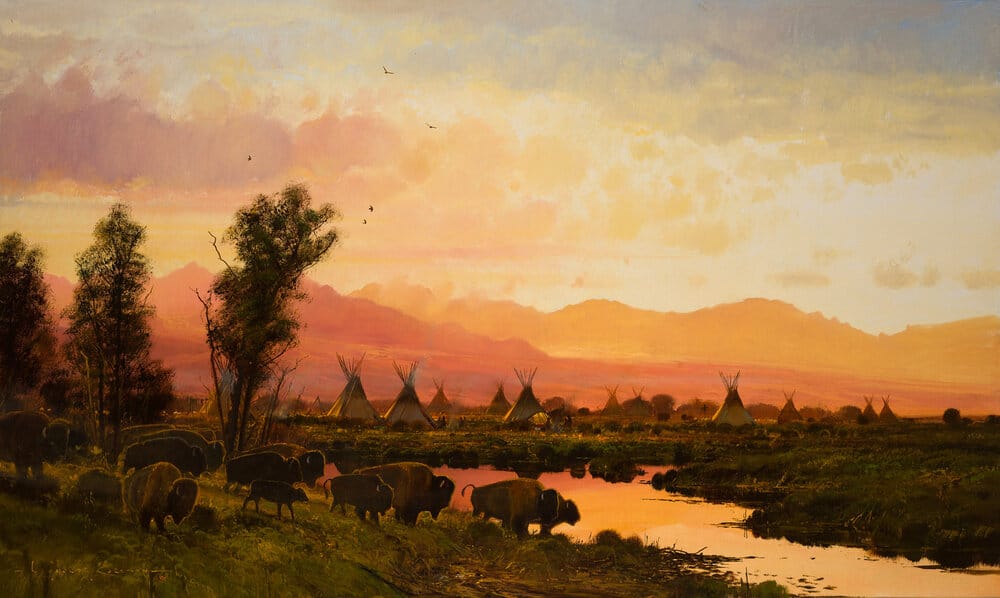
BR — I’m the same way, or I feel the same way at least. So fine art is expensive and, oftentimes, reserved for the wealthy. In an era that aims to remove barriers in all corners of culture, how do you address the cost of art in the gallery world that hasn’t evolved much in terms of access and affordability?
NC — So lately, the last few years, I’ve thought the exact same thing, about accessibility, because I really do want artwork in the hands of anybody. And a lot of times, it might not make business sense. If someone’s excited about something, I’m totally willing to give them a great deal. And sometimes, I’ve lost money on certain deals, but I like the person so much because they’re so excited about it.
BR — What’s the biggest regret you have creatively, or what’s the one thing you feel that you’ve yet to create or accomplish?
NC — Hopefully, there aren’t too many regrets, but what’s funny is I’ll visit museums around the world and I’ll see artwork created by certain artists. And I’m in awe sometimes.
There’s a Waterhouse painting of the Judgment of Herod and there’s John the Baptist’s head on a plate and the painting is ten or eleven feet high and six feet wide. And I’m looking at this thing going, “What am I doing?” Granted, I don’t paint religious scenes. It was one of the most amazing paintings I’ve ever seen in person. And I was like, “Wow, I gotta try harder.” And so hopefully, my regrets turned into me working harder and putting in a little more thought, effort, energy going forward.
BR — You mentioned this earlier about your dad asking what you thought about before you go to bed. But what would you do if you couldn’t paint anymore?
NC — I’ve thought about it too over the years. I’m like, “What else do I like to do?” I like to eat. I think I would be pulled back to art somehow, and it would be always coming back to painting. I’m like, “Oh, maybe I’ll work for a gallery, granted I hate people.” That’s terrible to say. But I hate the idea of having to be a salesman or sell.
I hate talking about myself when it comes to, “Hey, look, all my paintings are great or this and this,” because I know certain artists that are just fantastic at selling themselves. I’m hoping my work can speak for itself and so I don’t have to. That’s my whole goal.
And when my wife comes with me to shows, she’s great because she’s better-looking than I am, friendlier than I am. And she does a great job selling my work or talking to people, and again, engaging with people.
BR — Are there other things that if you could expand outside of the current genre of gallery or collectors, what would be some things you want to do?
NC — Now that I’m getting older, I’ve had a lot of younger artists come to the studio, and they’ll bring me some of their artwork to look at, to give them pointers and tell them how to get to galleries. And I always say, “Well, don’t ever think that you’ve made it because you’re in a gallery.”
There’s a thing in Utah called Creative Collaborative, where you discuss and talk about your work and people ask you questions about how you do certain things or how you go about certain things. People are in all different kinds of creative fields, and some overlap, which that’s the hope that you’re helping certain people that are struggling in a certain aspect to solve a few problems.
And then over the years, my dad’s been the greatest example of, like I said, sharing…
BR — How do you want to be remembered?
NC — I think any honors of men are transitory. I think I’d like to be remembered, hopefully, as just someone who shares their passion and enthusiasm and the love of the outdoors. And it happened to be with artwork. I think that might be the way to be remembered, and I thought, “Man, I’m not sure how much future we have left going forward, but I doubt I’ll make it in any of our history books or even a footnote.” And I don’t think that’s the goal. But it sure would be nice to be in a book of some kind.
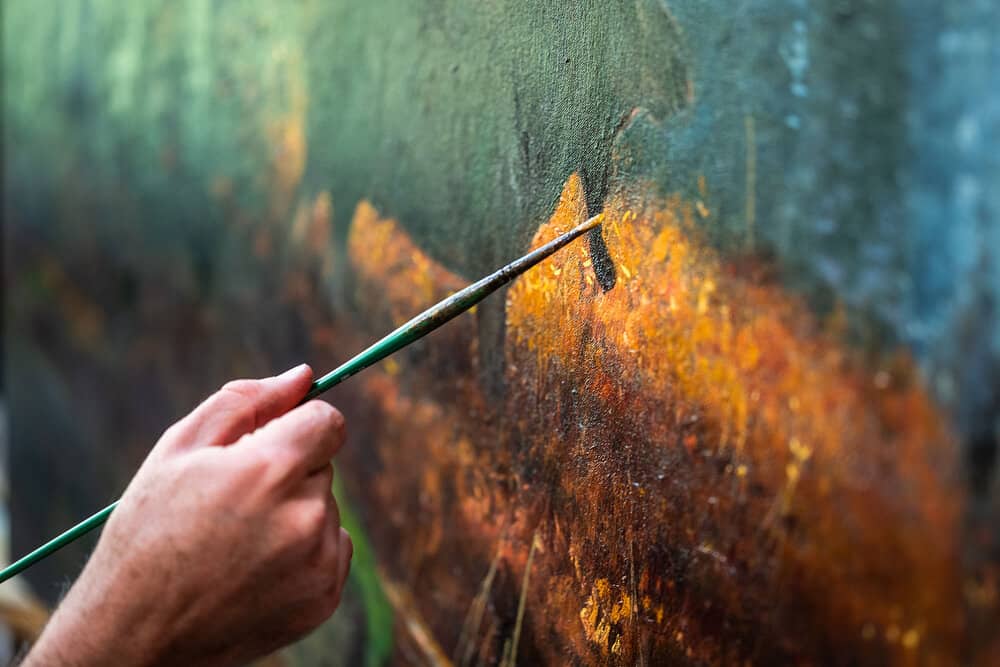
Related Stories


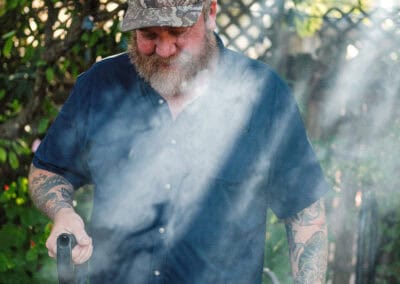
Latest Stories


